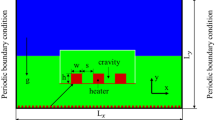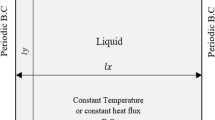Abstract
A new optimized model which can predict the heat transfer in the nucleate boiling at isolated bubble regime is proposed for pool boiling on a horizontal rod heater. This model is developed based on the results of direct observations of the physical boiling phenomena. Boiling heat flux, wall temperature, bubble departing diameter, bubble generation frequency and bubble nucleation site density have been experimentally measured. Water and ethanol have been used as two different boiling fluids. Heating surface was made by several metals and various degrees of roughness. The mentioned model considers various mechanisms such as latent heat transfer due to micro-layer evaporation, transient conduction due to thermal boundary layer reformation, natural convection, heat transfer due to the sliding bubbles and bubble super-heating. The fractional contributions of individual mentioned heat transfer mechanisms have been calculated by genetic algorithm. The results show that at wall temperature difference more that about 3 K, bubble sliding transient conduction, non-sliding transient conduction, micro-layer evaporation, natural convection, radial forced convection and bubble super-heating have higher to lower fractional contributions respectively. The performance of the new optimized model has been verified by comparison of the existing experimental data.












Similar content being viewed by others
Abbreviations
- A :
-
Area (m\(^2\))
- \(a_1\) :
-
The specific area occupied by these bubbles per unit heater surface
- \(a_2\) :
-
The specific area occupied by the sliding bubbles per unit heater surface area
- \(a_3\) :
-
The specific area over which transient heat conduction takes
- \(C_p\) :
-
Heat capacity at constant pressure (J kg\(^{-1}\) K\(^{-1}\))
- \(c_1\) :
-
Constant, see Eq. (9) (K m\(^{-2}\))
- \(c_2\) :
-
Constant, see Eq. (9) (K m\(^{-1}\))
- \(c_3\) :
-
Constant, see Eq. (9) (K)
- d :
-
Bubble departing diameter (m)
- E :
-
Relative error
- f :
-
Bubble departing frequency (Hz)
- G :
-
The chromosome vector
- \(G_0\) :
-
The ratio of bubble waiting period to total period of bubble generation cycle
- \(G_1\) :
-
The ratio of area of influence to projected area of bubble at departure
- \(G_2\) :
-
The ratio of average bubble stem area to the maximum project area
- \(G_3\) :
-
The ratio of actual sliding length to maximum theoretical distance between most compact arrangement of nucleation site densities
- \(G_4\) :
-
The ratio of area of radially forced convection influence to projected area of bubble at departure
- \(G_5\) :
-
The ratio of sliding nucleation site density to actual nucleation site density
- H :
-
An auxiliary parameter, see Eq. (41)
- \(h_{fg}\) :
-
Specific heat of vaporization (J kg\(^{-1}\))
- I :
-
Electrical current (A)
- k :
-
Thermal conductivity (W m\(^{-1}\) K\(^{-1}\))
- \(l_s\) :
-
Sliding length (m)
- L :
-
Heater length (m)
- N :
-
Nucleation site
- Nu :
-
Nusselt number
- OD :
-
Outside diameter of the heater (m)
- Pr :
-
Prandtl number
- q :
-
Heat (W)
- r :
-
Radius of rod heater (m)
- R :
-
Radius (m)
- Re :
-
Reynolds number
- Ro :
-
Roughness (m)
- T :
-
Temperature (K)
- t :
-
Time (s)
- u :
-
Velocity (m s\(^{-1}\))
- V :
-
Electrical voltage (V)
- x :
-
Characteristic length (m) or distance
- \(\upalpha \) :
-
Heat transfer coefficient (W m\(^{-2}\) K\(^{-1}\))
- \(\widehat{\upalpha }\) :
-
Thermal diffusivity (m\(^{2}\) s\(^{-1}\))
- \(\updelta \) :
-
Heat penetration depth (m)
- \(\upnu \) :
-
Viscosity (Pa s)
- \(\uprho \) :
-
Density (kg m\(^{-3}\))
- \(\uptau \) :
-
Bubble cycle period (s)
- \(\upvarphi \) :
-
Phase difference between voltage and electrical current
- b :
-
Bulk
- bsh :
-
Bubble super-heating
- g :
-
Growing
- l :
-
Liquid
- me :
-
Micro-layer evaporation
- nc :
-
Natural convection
- OD :
-
Outside diameter
- rfc :
-
Radial forced convection
- s :
-
Sliding
- stc :
-
Sliding transient conduction
- th :
-
Thermocouple location
- tc :
-
Transient conduction
- v :
-
Vapor
- w :
-
Wall or waiting
References
Han C, Griffith P (1962) The mechanism of heat transfer in nucleate pool boiling, Technical Report 7673-19. Massachusetts Institute of Technology
Alavi-Fazel S, Jamialahmadi M, Safekordi A (2009) Pool boiling heat transfer in dilute water/triethyleneglycol solutions. Chin J Chem Eng 17(4):552–561
Touhami B, Abdelkader A, Mohamed T (2014) Proposal for a correlation raising the impact of the external diameter of a horizontal tube during pool boiling. Int J Therm Sci 84:293–299
McNelly M (1953) A correlation of rates of heat transfer to nucleate boiling of liquids. Imp Coll Chem Eng Soc 7:18–34
Rohsenow W (ed) (1952) A method of correlating heat transfer data for surface boiling liquids, vol 74, pp 969–976
Mostinski IL (1963) Application of the rule of corresponding states for calculation of heat transfer and critical heat flux. Teploenergetika 4:66
Stephan K, Abdelsalam K (1980) Heat transfer correlation for natural convection boiling. Int J Heat Mass Transf 23:73–87
Fritz W (1935) Berechunung des maximal volumens von Dampfblasen. Physics 36:379–384
Cooper M (1984) Heat flow rates in saturated nucleate pool boiling a wide ranging examination using reduced properties. Adv Heat Transf 16:157–239
Gorenflo D (1993) Pool boiling. In: VDI Heat Atlas, (chapter Ha)
Alavi-Fazel S, Jamialahmadi M, Safekordi A (2008) Experimental investigation in pool boiling heat transfer of pure/binary mixtures and heat transfer correlations. Iran J Chem Chem Eng 27(3):135–150
Mikic B, Rohsenow W (1969) A new correlation of pool boiling data including the effect of heating surface characteristics. J Heat Transf 91:245–250
Moore F, Mesler R (1961) The measurement of rapid surface temperature fluctuations during nucleate boiling of water. AIChE 7:620–624
Judd RL, Hwang KS (1976) A comprehensive model for nucleate boiling heat transfer including microlayer evaporation. J Heat Transf 98:623–629
Benjamin R, Balakrishnan A (1996) Nucleate pool boiling heat transfer of pure liquids at low to moderate heat fluxes. Int J Heat Mass Transf 39(12):2495–2504
Nishikawa K, Fujitha Y, Ohta H, Hidaka S (1982) Effect of the surface roughness on the nucleate boiling heat transfer over a wide range of pressure. In: Proceedings of the 7th international heat transfer conference, vol 4, pp 1–66
Cornwell K, Schuller R (1982) A study of boiling outside a tube bundle using high speed photography. Int J Heat Mass Transf 25:683–690
Luke A, Gorenflo D (2000) Heat transfer and size distribution of active nucleation sites in boiling propane outside a tube. Int J Therm Sci 39:919–930
Manickam S, Dhir V (2012) Holographic interferometric study of heat transfer to a sliding vapor bubble. Int J Heat Mass Transf 55:925–940
Sateesh G, Sarit K, Das K, Balakrishnan A (2005) Analysis of pool boiling heat transfer: effect of bubbles sliding on the heating surface. Int J Heat Mass Transf 48:1543–1553
Thorncroft G, Klausner J, Mei R (1998) An experimental investigation of bubble growth and detachment in vertical upflow and downflow boiling. Int J Heat Mass Transf 41:3857–3871
Churchill S, Chu H (1975) Correlating equations for laminar and turbulent free convection from a vertical plate. Int J Heat Mass Transf 18(11):1323–1329
Mitchell M (1996) An introduction to genetic algorithms. MIT Press, Cambridge
Acknowledgements
The author is thankful to Department of Chemical Engineering, College of Chemistry and Chemical Engineering, Mahshahr Branch, Islamic Azad University, Mahshahr, Iran for financial support.
Author information
Authors and Affiliations
Corresponding author
Rights and permissions
About this article
Cite this article
Alavi Fazel, S.A. A genetic algorithm-based optimization model for pool boiling heat transfer on horizontal rod heaters at isolated bubble regime. Heat Mass Transfer 53, 2731–2744 (2017). https://doi.org/10.1007/s00231-017-2013-8
Received:
Accepted:
Published:
Issue Date:
DOI: https://doi.org/10.1007/s00231-017-2013-8




